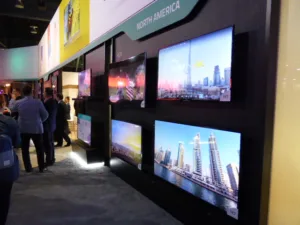Image: MekoMost of the H-series TVs from Hisense, which were introduced at CES 2016 (Hisense Begins Sharp Licensing), are now available in the USA. The H8 ($600 50H8C $700 and 55H8C), H5 ($200 – $500 in 32″ – 53″ sizes), H4 ($200 – $430 in 32″ – 50″ sizes) and H3 ($100 – $250 in 20″ – 40″ sizes) models have been launched, with the H7, H9 and H10 still to follow. The H7 series will cost $400 – $1,300 (43″ – 65″); the H9 will cost $1,000 (55″) and the H10 will cost $2,800 (curved 65″).
As well as the G6 and E6 premium OLED TVs, LG showed off two more affordable models at CES 2016 (LG’s Signature is Pure and Gimmick-Free): the B6 and C6, which have now been launched. Despite the ‘affordable’ tag, both feature Dolby Vision HDR, UltraHD resolution and UltraHD Premium certification. They have a peak brightness of 540 cd/m². The only difference between the two is that the B6 is flat and the C6 is curved. They are available now, starting at $4,000 for the 55″ and $6,000 for the 65″.
Optoma has produced a new projection screen that it says rejects ambient light. The ALR100 (100″) is designed for use with short-throw projectors and has a 0.42 gain measurement. It is available now.
Panasonic has rolled out a software update to its 2015 UltraHD TVs in Germany (CXW684 series), which enables a 90-minute timeshift function. A separate update has been sent to 2016 models in the DXM715 series, which enables HDR streaming from Netflix.
Polaroid has joined the Google TV movement, with a range of UltraHD models set to be launched this summer. The company says that the sets, using Google Cast technology, will range from 43″ to 65″ in size and between $500 and $1,000 in price. A 75″ TV will be launched in Q4, for $1,900.

